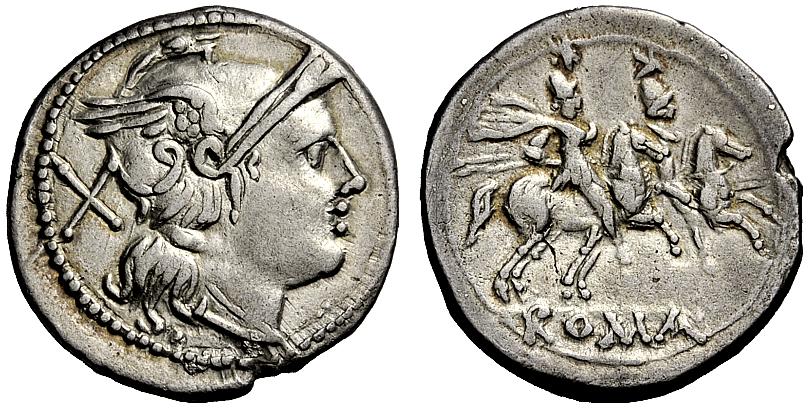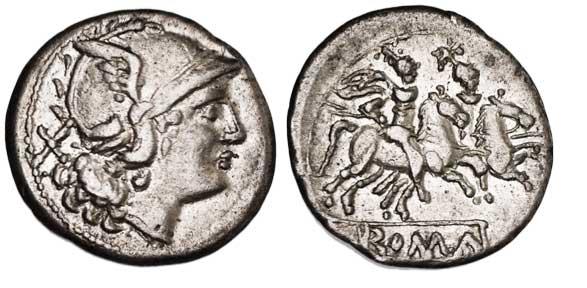CRAWFORD 44/5
Crawford 44/5 is the first denarius issue cited in his work. It contains six major
sub-varieties, and a number of variations can be observed in examples of this
issue, all of which have splayed or blunt end visors (none have peaked visors). Crawford emphasizes that
although this issue is among the earliest, the coins from the issue are roughly
contemporary with several of the following issues in his reference. The issue is dated after 211 BC.
The dating, relative to other issues has been variously discussed by other
numismatic scholars as new evidence and considerations emerge, most notably by
Charles Hersh3. Some argue that alternatives as early as 215/214 BC
are more likely dates for the first denarius, but the general consensus today is that
it began shortly before 211 BC..
It is curious that the six varieties of this issue appear to be no less distinct
from each other in style and design features than each is from the two
subsequent issues 45/1 and 46/1. The
distinction that Crawford implies is that all of the varieties in issue 44 are
Rome mint coins, where RRC 45/1 and RRC 46/1 are of
“uncertain” mints. That these are from the mint at Rome or not is
certainly impossible to determine. In the midst of
the 2nd Punic war, there is as much probability that these early denarii were
struck in military mints traveling with the legions.
The details described here in order to differentiate the sub varieties of RRC
44/5 are not absolute. The descriptions are of the most common characteristics
found together with the most frequently seen examples. There are countless
exceptions where characteristics span sub varieties, and reverse sub-types
typical to one sub variety are found paired with an obverse of another
sub-variety. This overlap is true of ornamentation details where for instance
the style and all aspects of the example point to one sub-variety, but a
characteristic only found in another sub-variety is observed.
These
phenomena suggest that some sub-varieties may have transitioned from others over
time, rather than being concurrently produced at different workshops and by
different engravers. In fact, there is now some rather convincing die link evidence assembled by
Pierluigi, linking
groups 1, 3 and 4 (Crawford plates IX.10, IX.16. and IX.20) to the same mint
location, for denarii and the quinarii stylistically related to these
groups.
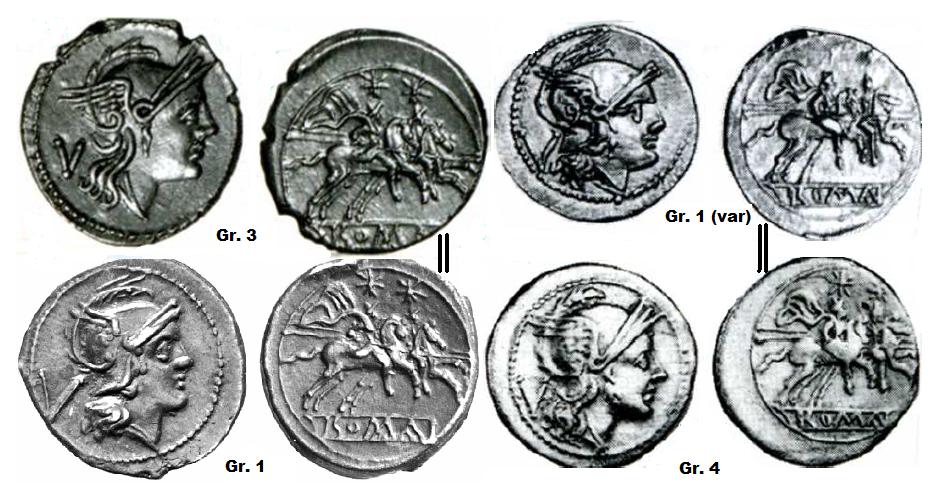
44/6 Die Links
Crawford 44/5 is found with semi (or pseudo) incuse ROMA legend, and with legend
in relief on the reverse. Crawford and others have suggested that there are rare
examples of 44/5 with fully incuse legends. There are examples known that appear
to be nearly fully incuse but in all observed instances, some relief is evident,
and the incuse appearance can be attributed to wear or striking. Perhaps
the the Owl Enterprises/Tom McKenna Aurelia collection example is as close to
fully incuse as has been seen, but even this example displays subtle areas of
relief around the letters in the legend, whereas RRC 45/1 and the unique
Bastianelli specimen
of 68/1 with incuse legend show no relief in the legend.
Often splayed anonymous visor coins are by default, misattributed to this issue.
Attribution of these varieties is quite difficult and does require careful
observation and a knowledge of the distinguishing characteristics. Because
RRC 44/5 has so many interesting variations and it is the first early denarius
encountered in the major references, its not surprising that it is used as a
catch-all for this difficult series. The most common issues to be
misattributed are RRC 46/1, 68/1b, 75/1c, and 107/1d. Inexplicably,
peaked visor issues are also misattributed to this issue.
|
|
RRC 44/5 IX.10 - Group 1
|
1
RRC 44/5
IX.10 |

Fig. 44/5.1
From the Phillip Davis Collection

Fig. 44/5.2
Photo Courtesy of Numismatica Ars Classica,
NAC AG, Auction 33, lot 202
|
|
Obverse: The head of Roma is generally petite in relation to the overall
motif and particularly in relation to the mark of value “X”. The visor is short,
extending only a short distance beyond the helmet, and is made up of two or
three generally straight lines, gradually splayed directly from the hinge over
the ear. Unlike the 44/5 variety in plate IX.16, which also has straight
visor lines, this variety lacks the two small demarcating lines
connecting the three visor lines at the outside end of the visor. The border
diameter is relatively small (on both obverse and reverse) compared to other
varieties, and as a result, examples frequently have a large area of the flan
outside the beaded border.
Reverse: The tail of the horse is always extending fairly straight behind
the horse. The riders are well proportioned in size to the horses which
are relatively slim. The legend “ROMA” is spelled out on a raised tablet in semi incuse letters.
Notice the variation in
cape style between figure 44/5.1 and figure 44/5.2. This variety is seen with
various cape styles and may share reverse styles with numbers groups 3 and 4 below,
Crawford plates IX.16 and IX.20. Fig.
44/5.1 above is most closely aligned with
the Crawford plate IX.10 reverse, with a billowing cape, flying high behind the
rider's heads. Fig. 44/5.2 although similar in obverse style and
fabric, displays a three-line visor and a reverse style more closely aligned
with Fig 44/5.9 (Crawford plate coin IX.20).
Perhaps with further study this will be worthy of its own "not-in-Crawford"
designation.
Distinguishing Characteristics:
|
- Small head of Roma with short, slightly splayed visor made up of
two or three straight lines. The visor does not extend far from the forehead
-
Reverse Horse’s tail extended out from horses
|
|
RRC 44/5 IX.13 - Group 2
Two sub-varieties are known of the issue of RRC 44/5
illustrated in IX.13. These bear a few common characteristics
including a fairly long visor, the lines of which splay subtly outward away from
each other at the outside end of the visor, combined with the reverse horse's
tail hanging down.
The first sub-variety is characterized by a relatively narrow
head of Roma on the obverse and rather un-sophisticated features. The
second sub-variety has a slightly broader head of Roma and is rendered in more
life-like and realistic facial features, see figure 44/5.4.
The "Dot" Variety
The second sub-variety is sometimes
found with a "Dot" below the truncation of the neck. These rare examples
typically have skillfully rendered obverses.
See figure 44/5.5 below for an example of the "dot" variety. This second variety is believed to be transitional to group 5 in the "horse tail down" variations .
Although the obverse is most closely similar to group 2, the reverse style is remarkably more similar to group 5 in all aspects except the frame around ROMA.
The Group 5 frame lacks the curved left edge of the frame which is seen on the groups 1-4 semi-incuse variations including the dot variety. No reverse die links have been found between the group 2 sub-varieties;
however, at least one group 5 obverse is known with a dot below the head of Roma (see fig 44/5.12).
|
2
RRC 44/5
IX.13 |

Fig. 44/5.3
Varesi 58, Lot 1237
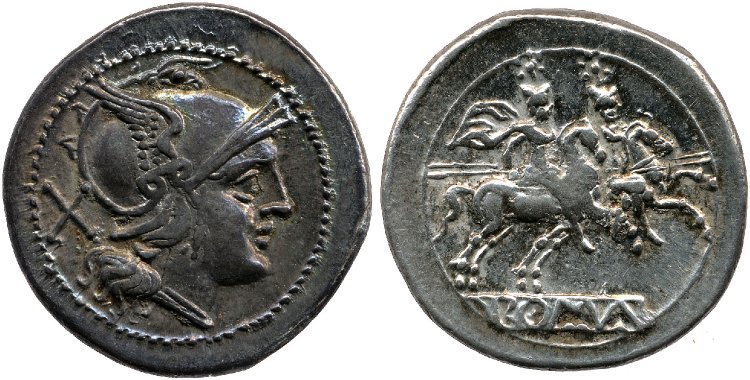
Fig. 44/5.4
© Trustees of the British Museum
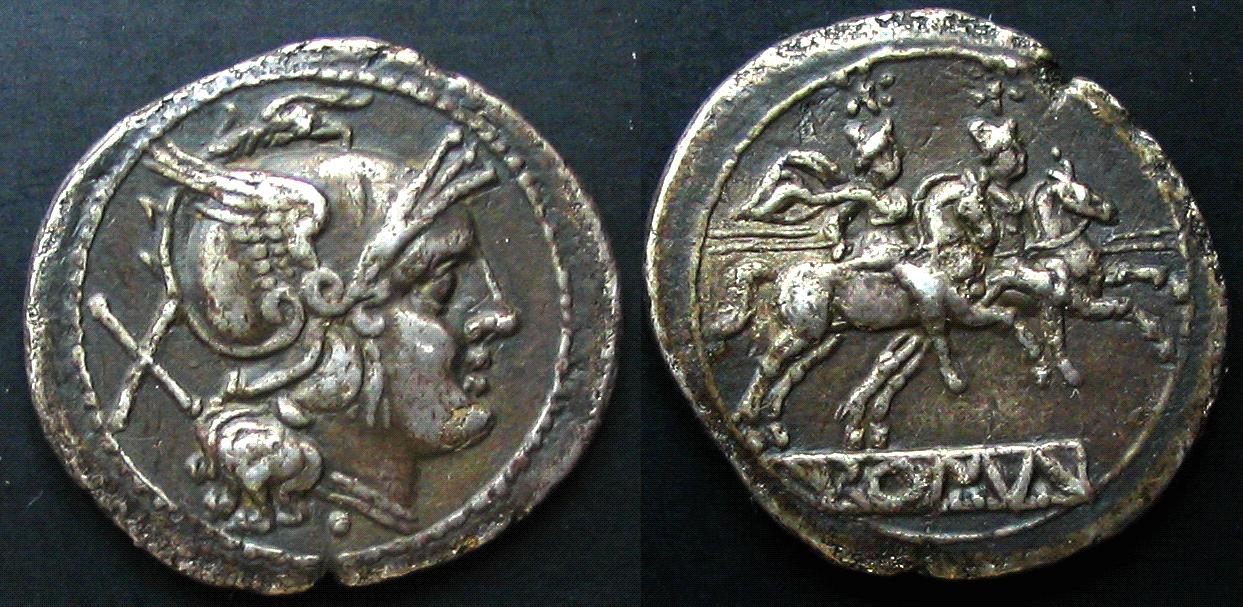
Fig. 44/5.5 - "Dot Variety"
CGB 45, lot 199
|
|
Obverse: Similar to the rather primitive style execution in
group 1 above, but with a much
larger head. The visor extends much further outwardly from the helmet and is splayed into
3 lines at the tips. The outside lines are slightly curved away from each other. Sometimes the tips are connected with short demarcation lines (see Fig
44/5.4.).
This variety is sometimes seen with a dot below the truncation
of Roma's neck on the obverse (See figure 44/5.5)
Reverse: The dioscuri are larger bodied in relation to the horses and the general motif.
The legend “ROMA” is partially incuse as shown in the photos. The horse’s tail is trailing downward, (
compare to group 1 and group 3 where the tail trails straight outward.)
Distinguishing Characteristics:
|
-
Splayed visor, outside lines of visor nearly always slightly curved in opposite
directions from each other, visor extends further from the helmet than the small
head version #1 above
-
Horse’s tail trailing downward
-
Curved left side of frame around ROMA
|
|
RRC 44/5 IX.16 - Group 3
This variety is characterized by a helmet wing angled straight back or downward, unlike any other variety and loose locks below the helmet without hair binding (elsewhere also seen only in group 4).
|
3
RRC 44/5
IX.16 |

Fig. 44/5.6
Photo Courtesy Classical Numismatic Group
Sale 70 Lot 666

Fig. 44/5.7
Private collection
|
|
Obverse: The visor is splayed from
two straight or nearly straight lines originating on the helmet over the ear, and a third shorter
line between the two long lines extending from the front of the helmet, so the
visor is three lines at the end. Near the end, the three lines are often, but
not always, intersected by two small demarcating lines connecting the three visor lines near the outside
tips of the visor. Hair behind helmet is unbound, often referred to as the
"loose locks" style. Unlike all other
varieties of Crawford 44/5, the tip of the wing on the helmet is pointing down,
slightly lower than the "wrist" of the wing.
Reverse: This, group 4 below and group 1 above share the characteristic of an extended tail behind the near horse. The horsemen are relatively small and proportioned similarly to
group 1 above, but the cape is most commonly streaming as in figure
44/5.6, although it
is also found billowing (fig. 44/5.7) in the same style as the group 1
example in figure 44/5.1.
The legend “ROMA” is semi-incuse on a raised tablet.
Distinguishing Characteristics:
|
-
Visor defined by two long straight lines extending from the hinge over the ear, a third short line between the two long lines extending from the front of the helmet
-
The wing tip on the helmet is lower than the "wrist" of the wing, and usually points slightly downward.
-
Hair is unbound, trailing behind the ear to the back of the neck in a loose fashion.
-
Roma's Necklace is a simple raised line extending from high in the back of the neck to the front point of the truncation of the neck.
-
Reverse Horse’s tail extended outward from the horses
|
|
RRC 44/5 IX.20 - group 4
The following variety is similar ornamentally to number 3
above, but somewhat different in the obverse style of Roma. Although this variety is one
of the scarcest of the C44/5 family, the known varieties show many different styles and variations
in ornamentation. Of the few specimens observed, there are at least five very distinct cape styles.
|
4
RRC 44/5
IX.20 |

Fig. 44/5.8
Photo Courtesy of Numismatica Ars Classica
NAC AG, The RBW Collection, Auction 61, lot 182

Fig. 44/5.9
© Trustees of the British Museum

Fig. 44/5.10
Photo Courtesy of Numismatica Ars Classica
NAC AG, Auction 46, lot 333
|
|
Obverse: Roma head is relatively large. The visor is splayed with the outside lines curving away from each other.
It is interesting to note that the variety depicted in RRC shows no apparent demarcation lines between the long visor lines.
As in group 3; however this is actually the exception and most dies of this variety display very pronounced
demarcation lines connecting the three outside tips of the visor. The hair behind helmet is not bound .
Roma's necklace is beaded and more elegant than group 3
above. It extends to a position in front above the truncation of the neck.
Reverse: The near horse displays a tail extending outward as in
group 1 and group 3 above.
The ledgend ROMA is on raised tablet or lined border, but always semi-incuse style. Notice the variation in cape style between figure
44/5.8 and figure 44/5.9.
Some of the reverse variations found on this variety are also found on group 1.
Distinguishing Characteristics:
|
-
Outside lines of visor curved away from each other. Two narrow strands of hair from behind the
ear in front of the helmet neck guard flap. The hair is unbound.
-
Roma's necklace is beaded and more elegant than group 3 above.
It extends to a point
in front above the truncation of the neck.
-
Reverse Horse’s tail extended out from horses
|
|
RRC 44/5 IX.22 - group 5
Group 5 is similar to Group 6 in style. The key immediate differentiation will be in the ROMA
legend. The group 5 legend is semi-incuse or in the last stages of transition to relief style. The font is larger than groups 6 and 7, and the letters are broad stroked. Group 6 legend is always in relief.
|
5
RRC 44/5
IX.22 |

Fig. 44/5.11
© Trustees of the British Museum

Fig. 44/5.12
Negrini 31 lot 175
Note Dot below truncation

Fig. 44/5.13
Photo Courtesy of Numismatica Ars Classica
NAC AG, The RBW Collection, Auction 61, lot 183
|
|
Obverse: Roma head is the largest of all the sub varieties, using most of the available space
within the beaded border. The curved visor extends from the hinge above the ear as a solid mass
or very close parallel lines but
divides into three separated lines above the forhead. At the end of each line is frequently a tiny pellet.
Multiple hair locks trailing from behind the ear, tied with a cord and bunched.
Reverse: Horse's tail hangs down from behind the closest horse.
The legend “ROMA” is semi-incuse in large letters but with fewer of the incuse
characteristics than groups 1-4, and with the beginnings of a transition to
relief.
Distinguishing Characteristics:
|
-
Large head of good style and natural uniformity, curved splayed visor (Sydenham Helmet A.2)
-
Reverse Horse’s tail hangs down from behind the closest horse
-
The legend ROMA is semi-incuse. Usually the frame is without a left side and enclosed only with the peripheral border
|
|
RRC 44/5 IX.24 - group 6
There is reason to suggest that the following variety - that
illustrated in the Crawford plate IX.24, is separated from the other RRC 44/5
varieties at least in terms of time if not in terms of location. This is
supported by the fact that no known Quinarii or Sestertii exist with this style
where quinarii are known for groups 1-5 and Sestertii are known for only `groups 1-4.
There is also reason to believe that there are two distinct
issues within this sub-variety - Those with tufts on the back of the helmet and those without.
It would seem that this would be an inconsequential detail, but the theory is
supported by the siblings to which they are related. The anchor
symbol sibling always comes with gryphon tufts on the back of the helmet.
The Prow (rostrum tridens) always is found without.
|
6
RRC 44/5
IX.24 |

Fig. 44/5.14 - No Tufts
Photo Courtesy of Numismatica Ars Classica,
NAC AG, Auction 51, lot 6

Fig. 44/5.15 - Tufts
Classical Numismatic Group eAuction 238, lot 710
|
|
Obverse: Large head of Roma very similar in style to group 5 above, but narrower
as a rule.
The Visor is distinctively solid from the hinge over the ear to the outside tip with only
a suggestion of lined division and points near the end. “Tufts” on the back of the helmet may or may
not be in evidence (see discussion at the beginning of this section). Multiple hair locks trailing from behind the ear, tied with a cord and bunched.
Reverse: Horse’s tail hangs down. Legend ROMA is seen in small raised letters in a raised line border.
Distinguishing Characteristics:
|
-
The Legend ROMA is in relief in a small frame and font compared to groups 1-5
-
The frame around ROMA is 3-sided, without a left edge
-
Nearly solid, broad curved visor, sometimes separating to three lines near the
end (Sydenham helmet A.1.)
-
Near horse’s tail hangs down
Sibling Varieties: No Tufts- RRC 62/1 (Rostrum Tridens)
Tufts- RRC 50/2 (Anchor)
|
7
RRC 44/5
No Crawford Plate |
RRC 44/5 Limp Tail Variety -
group 7
In addition to the splayed visor varieties in the Crawford plates,
there are other patterns of style that are close enough to be classified as variety 44/5
but stylistically different enough to be regarded as a different major subvariety.
Number seven is quite similar to numbers five and six, but the stylistic differences are relatively
substantial and consistent across several examples. The consistency between the examples
suggests a different workshop or a different engraver for both the obverse and
reverse.

Fig. 44/5.16
Photo Courtesy Classical Numismatic Group

Fig. 44/5.17
© Trustees of the British Museum
|
|
Obverse: Large head of Roma very similar in style to group 5 and group 6 above.
The curved visor is made up of two main raised lines and a third center line extending from slightly less than half way into the helmet from the outside tips.
The tips of these lines are always pointed, unlike the other 44/5 sub-varieties.
The tufts on the back of the helmet are small, and sometimes odd shaped like
spines as in figure 44/5.15.
Reverse: Horse’s tail hangs down but in a consistently “limp” style
with relatively little wave or curve in the downwared extension.
Distinguishing Characteristics:
|
-
Broad curved visor of two main raised lines and a shorter center line extending to pointed tips (Sydenham helmet B.3.)
-
Near horse’s tail hangs down in a limp fashion.
(Compare with other varieties with hanging tail where the tail is rather wavy.)
|
CRAWFORD 46/1
Also believed to be from an uncertain mint, RRC 46/1 is often misattributed as
RRC 44/5. This issue is depicted in RRC plate X.1 with the distinctive single
line-boundary defining the visor and the two line legend frame on reverse.
This issue is now known through a series of reverse die links to include at
least three different, very diverse obverse styles, both of which are missing in
Crawford, although one is the anonymous sibling to RRC 60/1c (Caduceus).
These new varieties shall be designated here as 46/1(b) and 46/1(c).
Here is a 46/1 die link diagram that supports this relationship.
Here is a detailed discussion and die study of the 46/1 series.
STUDIO DEI CONII DI RRC 46/1 E 60/1c by Pierluigi Debernardi
reprinted with permission from the October 2013 edition of Panorama Numismatico.
|
9
RRC 46/1
X.1 |

Fig. 46/1.1
New York Sale IV
Lot 313

Fig. 46/1.2
© Trustees of the British Museum
|
|
Obverse: Style and size of the head of Roma is similar to 44/5 X.22,
above. The visor is unique in that it is a curved visor, blunt at the outside
perimeter, and defined by two curved lines from the hinge over the ear, splaying
apart, and connected at the end with a single demarcating line. There is no
third line between the top and bottom lines that form the visor.
Reverse: The word ROMA raised and bounded by two raised lines, one on top and the second,
a vertical line on the right.
Horses are “chubby”, and the rider’s heads are a bit large for their bodies.
Distinguishing Characteristics:
|
-
Obverse curved visor defined by a single line, above, below and in front
-
Reverse two sided frame around ROMA, top and vertical right
-
Chubby (a little overweight) horses.
|
46/1(b) Not in Crawford
46/1(b) displays a completely different obverse style from 46/1 but is known to be of the same issue by a reverse
die link between an example in Museo Archeologico Nazionale di Napoli and a coin of the more common 46/1 obverse.
Here is a 46/1 die link diagram that supports this relationship. This obverse style is rare, but a small number of fine examples have been offered for sale in the last 50 years.
|
10
RRC 46/1(b)
Not in Crawford |

Fig. 46/1(b).1
Museo Archeologico Nazionale di Napoli

Fig. 46/1(b).2
Photo Courtesy of Numismatica Ars Classica
NAC AG, Auction 7, lot 549
|
|
Obverse: Curved visor splitting to 3 lines at the outside end. Some
examples display the outside lines splaying away from each other near the outer perimeter. The hair below the helmet is bound with a cord. There is a full "ball" of hair below the cord with locks
of hair trailing below the ball. The griffon tufts are geometrical triangles, the points of which extend straight out away
from the helmet. In some examples, the tufts are upon a raised
ridge, giving the impression of a saw blade (see the index image).
Reverse: The reverse style is stylistically Identical to the
more common RRC 46/1, but for the ROMA legend which is variably found either as 46/1 with a two line top, right frame, and
also nearly fully in exergue with a line at the bottom. Some examples show a nearly full exergual line with a
bisecting vertical right line .
Distinguishing Characteristics:
|
-
- Curved visor on a somewhat narrow head of Roma in good style
-
- Three-pendant earring
-
- Reverse cape style as 46/1
|
46/1(c) Not in Crawford
46/1(C) is the rare anonymous sibling to (also rare) RRC 60/1c (Caduceus). The example
illustrated here is a reverse die link to the fine 46/1(b)
specimen in NAC 7 lot 549 offered at auction March 1994. This die link, in
combination with the die link between 46/1 and 46/1(b) suggests
that this and the other two major obverse styles were the product of the same
mint. Here is a 46/1 die link diagram that supports this relationship
|
11
RRC 46/1(c)
Not in Crawford |

Fig. 46/1(c).1
Photo courtesy of The American Numismatic Society
|
|
Obverse: Curved visor of two fine lines, splayed from hinge
over the ear. There is usually a short third line between the two lines
extending from the forehead to the outer perimeter. Often the visor lines
are terminated with tiny pellets. The stylistic
rendering of Roma's head is similar to RRC 44/5 IX.22, but Roma's head is
narrower, the hair below the helmet is not as full as 44/5 IX.22.
Reverse: The reverse style is stylistically Identical to the
more common RRC 46/1, but for the ROMA legend which is unlike 46/1, nearly fully in exergue
with possibly a line at the bottom. 46/1 displays lines at top and right
consistently. Although there is no evidence of this vertical line,
all known specimens of 46/1(c) are slightly off-center and do not reveal the
entire legend.
Distinguishing Characteristics:
|
-
- The facial style of the obverse Roma is as sibling 60/1c with Caduceus
-
- The reverse legend "ROMA" in raised letters in exergue, sometimes with line
below
-
- Curved visor on a somewhat narrower head than 44/5 IX.22
-
- Hair below helmet is not as full on comparable 44/5 IX.22 varieties
Siblings: RRC 60/1c (Caduceus)
- Also, see example in 46/1 die link diagram
|
CRAWFORD 53/2
Crawford 53/2 introduces the peaked helmet visor. This group is, much like 44/5, not a single
variety, but an assembly of many different varieties, all of which have some common
characteristics. All are ornamentally similar, and all are roughly from the same point in time. Crawford suggests “after 211 B.C.” but
nearly all subsequent research suggests these arrived later, probably sometime after 208 B.C.
RRC suggests a weight standard based on a denarius of 4.5 gm., but there is a broad range of weights for examples demonstrating all of the stylistic characteristics
of 53/2, from less than 3.5 grams to more than 4.5 grams. A recent
weight comparison study of several hundred examples of these two groups completed by Pierluigi suggests that
the 53/2 coins are statistically lighter than the 44/5 coins:
|

|
Crawford's suggestion that the 53/2 series was struck on a weight standard of
4.5 appears to be somewhat in question, and this study suggests that perhaps
this very large series spanned the transition from 4.5 to 3.8 gr.
It is believed that weight uniformity was loosely controlled in the mint by
weighing a fixed quantity of silver to average an aim weight across several
similar sized flans.
|
Crawford illustrates 8 stylistic sub-varieties in plate X without any descriptive differentiation
in the catalogue. There are several distinct sub-varieties that have been discovered subsequent
to RRC. In the analysis presented here, 10 groups are represented, two of which are not
represented in the plates of RRC. These sub-varieties are apparently from the hands of several die engravers,
showing not only slightly different ornamental details, but also very distinct styles within
these sub-varieties, some of which are extremely elegant. Each of these 10
varieties represents a distinct issue, separated either by time or place.
This is supported by the fact that as of this time, no die links are known
to span across the boundaries of these groups, suggesting that the dies never
shared a “die box” in the same time, or mint workshop.
That these separations are temporal or geographical is the
subject of much debate, but some assumptions may be suggested by the known
hoards of the time. Although there is no certainty of the order and
sequence of these issues, there is some evidence that groups 0, 1, and 4 are early
based on their frequency and distribution in hoards of this
time and the overall heavier weight distribution closer to the 4.5 gm. standard
of a large sample of group 4 coins. The Orzivecchi and Tarquinia hoards include only Groups 0, 1 and 4. Group 9 is almost certainly the latest. This, the most
common 53/2 variety by far, is totally missing in some large hoards containing substantial
numbers of groups 4, 5, and 6, and the weight distribution of a large sample
suggests that they were based on the later 3.8 gm. standard. Additionally, the relationships to the symboled
siblings suggests both sequence and geographical separation.
Further discussion of the separation and
sequential transition is described in the detailed description of the groups.
The key distinguishing obverse features are the helmet, various
patterns of hair arrangement, and the
spacing of the griffon tufts on the back of the helmet. The key distinguishing reverse features are
the frame around the legend ROMA, the cape trailing the near horseman, the posture of
the horses, and the stars above the heads of
the horsemen.
Ultimately, style is the key determination with this series. Many distinguishing characteristics
of ornamentation are best regarded as “usually the case” because there are seemingly
endless exceptions to the rule with most of the distinguishing characteristics.
Cape styles are among the key characteristics that help distinguish
(in combination with other characteristics) between sub-varieties of Crawford 53/2.
The three styles are described as follows:
 |
"Streaming" – Somewhat characteristic of a banner “streaming” in the wind. |
 |
"Flag-like" or "Waving" – Characterized by 3 or 4 roughly parallel wavy lines, usually ending with the tips pointing upward. |
 |
"Scrolling" or "B" Cape – The cape appears to be billowing, and filled with air.
The end of the cape is in the form of a “scrolling” B. This style is found on the plate X.15 sub-variety of Crawford 53/2, but it is also found
as a variation on other 53/2 varieties that are normally found with a flag cape,
such as the X.16 anonymous sibling to the "club" series, RRC 75/1c and other symboled or signed varieties. |
This section is largely the fruit of the analysis completed by Pierluigi.
Richard Schaefer’s Republican Die Project (RDP) has also been extremely valuable in identifying
examples of these varieties and how they fit into the grand scheme of things. I am also
indebted to Ross Glanfield for advice and input on the definitions in this section.
** Revue Numismatique 2018 - A New Arrangement for RRC 53/2
In the 2018 edition (175e volume) of Revue Numismatique, we have published an article “A New Arrangement for RRC 53/2”.
The purpose of that article extends beyond the main purpose of this website, (identification and classification in the context of RRC),
in that it brings new evidence in terms of die link analysis, hoard evidence, historical context, theories of probable mint locations,
and a proposed sequence of the respective sub-varieties. The nomenclature used in the article was necessarily different than what is
presented here but does map closely to the divisions in most cases. The nomenclature used here is still valid for the intents and purpose
of this site, and has been referenced not only in the trade, but in museum cataloging. A cross-reference has been added here in the
headings of each group. In addition, the image labels extend their description with the form “(RN-##)” to designate the
subgroup classification used in the article.
|
53(a)(Review Numismatique - A1)
|
|
This variety is not pictured in the Crawford Plates. It is distinctly different than any of the other
53/2 varieties and the obverse style is closest to Crawford 88/2a which is the scarce variety in the spear head series.
The variety was discovered by Pierluigi and is very scarce, but is represented by at least 13 obverse and 12
reverse dies.
This series is identified as 53A because it is different in so many ways from the
other 53/2 varieties. The short flagged cape is unlike any of the other
varieties, the four locks of hair, the visible hair cord (visible hair cord on
anonymous issues is otherwise only
found in C44, C46 and 77A), and the remarkable workmanship on some of the examples
draws this apart. The trapezoidal frame suggests an early style.
|
13
RRC 53(a)
(Not in Crawford) |

Fig. 53/2.1 (RN-A1)
Bibliothèque Nationale de France
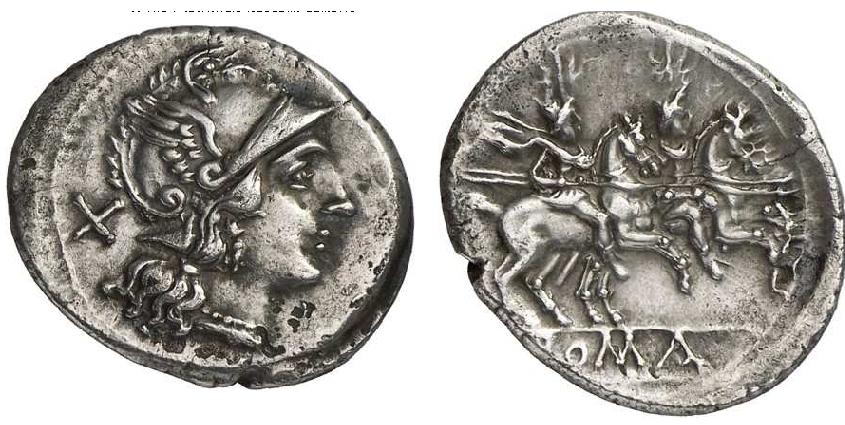
Fig. 53/2.2 (RN-A1)
BWB MA-shop, Nov. 2009
|
|
Obverse: Head of Roma with four locks of hair at the back of the neck.
(only this and group 7 have four locks instead of 3). The hair binding is clearly
visible above the four locks of hair, and this is unique in the 53/2 series. Most dies exhibit many small griffon tufts
at the back of the helmet, and many dies display a highly detailed 3-dimensional
rendering of the griffon tufts as illustrated in Figure 53/2.2 above. Helmet visor is usually short, not extending far from the forhead.
Reverse: Horse's hind legs are bent at the hock, so that the hind hooves are ahead of the
hock. (This feature is also seen in group 3 dies, but with an entirely different style obverse).
The far horse's tail is always visible. The ROMA legend is surround by a trapezoidal frame.
Distinguishing Characteristics:
|
-
Obverse four locks of hair.
-
Hair cord is clearly defined above the four locks.
-
Reverse horse's hind legs bent at the hock (first joint below the hindquarters)
-
Very small tufts behind the helment of Roma
-
Legend ROMA surrounded by trapezoidal frame
Weight Distribution Analysis: The sample frequency of group zero is small and the weight
distribution is unrevealing, with three example above the 4.5 gm standard,
Six below the 3.8gm later standard and five examples in-between. |
 |
|
|
Sibling: RRC 88/2a (Spearhead),
This relationship is tentatively suggested by the closeness of the obverse style,
but note that this symboled series has only 3 locks of hair. The reverse
is very different in many ways.
|
Group 1 - Rearing Horses(Review Numismatique - B1)
|
|
This variety is believed to be one of the earliest issues of 53/2 based on its
consistent presence (though in small numbers) in early hoards where contents
included 53/2 examples. It is nearly always found with a loop under the visor, believed to be an attribute of Sicilian origin.
There are no symboled siblings for this group.
|
14
RRC 53/2
X.13 |

Fig. 53/2.3 (RN-B1)
Private Collection

Fig. 53/2.4 (RN-B1)
Photo Courtesy of Numismatica Ars Classica,
NAC AG, Auction 25, lot 247
|
|
Obverse: There is usually a small loop under the visor in front of the forehead.
The loop is often discretely represented as a small lump, other times it is
clearly a loop as shown in Fig. 53/2.4. Tufts at the back of
the helmet are very small and close together.
Reverse: More so than any other variety in this issue, the horses appear to be
almost rearing up,
rather than galloping forward, particularly the far horse, with forelegs farther above
the exergue than on other varieties. The legend ROMA is in a trapezoidal frame. Cape style is Flag-like or Waving.
There is nearly always a pointed horse's tail visible between the legs.
The horses and riders appear rather small and distant, compared to other
varieties.
Exceptions: There are rare examples that are clearly of this style
but with horses that are galloping broadly forward rather than rearing up.
See "Group 1 Variations" below.
Distinguishing Characteristics:
|
-
Loop under visor (There are scarce exceptions without)
-
Reverse horses with fore-hooves high in the air above the exergue
-
Trapezoidal frame
-
Very small tufts behind the helment of Roma
-
"Waving" flag cape style
-
Second horse's tail is visible
Group 1 Variations
Unmistakably 53/2 Group 1, but this is a scarce
variation without a loop under the visor. |
 |
Group 1 obverse combined
with transitional reverse with horses in a posture of galloping forward rather than rearing up.
|

|
|
Group 2 - scrolling "b" cape(Review Numismatique - B2)
|
|
The Group 2 coins are characterized by a rider's cape which ends in two loops in
the form of a "B". But for the cape style, the reverse is in a similar style
to Group
1 reverse, relatively small thin horses but the horse's forehooves are not
raised as high.
A scrolling "B" cape is also seen rarely on the group 4 dies as well as
its sibling "Club" series coins.
|
15
RRC 53/2
X.15 |

Fig. 53/2.5 (RN-B2)
Private Collection

Fig. 53/2.6 (RN-B2)
Photo Courtesy Harlen Berk Ltd.
|
|
Obverse: Tufts on the helmet are very close together as are all of these
early varieties, 0-4.
Reverse: The near horseman displays a “scrolling” style cape with curled ends suggesting
that the cape is billowing in the wind. ROMA appears in a trapezoidal
frame although the bottom of the frame is often obscured, giving the
impression that ROMA is under an exergual line. The pointed tail of the far horse is visible between the horse’s hind legs.
NOTE: the scrolling cape is found in a scarce sub-variety of Group 4 with a rectangular frame.
This variation usually lacks the extra tail.
Distinguishing Characteristics:
|
-
1. Reverse scrolling "B" style cape
-
2. Trapezoidal frame
-
3. Large stars above riders heads
-
4. Pointed tail of the far horse is visible between the legs
|
Group 3 - crouching Hind legs -
Hatched Tail(Review Numismatique - A2)
|
|
The horses on the group 3 dies are larger and appear closer to the viewer. The hind legs are always
in a crouched pose with the hock bent further to the left than any other part of the leg.
The tail between the horses is nearly always present and in the form of several
horizontal "hatched" lines.
|
16
RRC 53/2
X.14 |

Fig. 53/2.7 (RN-A2)
© Trustees of the British Museum
.jpg)
Fig. 53/2.8 (RN-A2)
Private Collection

Fig. 53/2.9 (RN-A2)
Staatliche Museen zu Berlin
|
|
Obverse: Two raised lines over visor.
Tufts on the back of the helmet very close together.
Reverse: The word ROMA in a trapezoidal frame with the bottom line shorter than
the top line, and angled lines connecting the top and bottom.
The angled lines are often hidden on off-center coins. Horseman’s cape is of the “streaming” style.
There is an interesting extra horse’s tail in the form of several short paralell horizontal lines extending between the pairs of horse’s hind legs.
Distinguishing Characteristics:
|
-
Reverse legend ROMA in trapezoidal frame
-
Extra horse’s tail of several short paralell horizontal lines
-
Tufts on back of helmet are close together
-
“Streaming” style cape
|
Group 1-3 Relationships and Variations
|
|
Groups 1-3 are drawn together with many similarities. All have trapezoidal
frames, group 1 and 2 share very similar reverse styles, and groups 2 and 3
share similar obverse styles.
Weight Distribution Analysis:
The weights of Groups 1-3 tend to fall around the 3.8 standard, with only 20%
of the distribution around the 4.5 standard. |
 |
The following examples are transitional varieties all of which break some of the
rules described above but displaying stylistic similarites to groups 1 through
3.
|
 |
Obverse of Group 1.
Reverse with streaming cape and extended hind legs |
 |
Obverse of Group 3.
Streamin cape and hind legs extended |
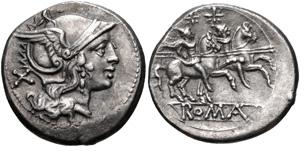 |
Group 1 obverse and reverse style
Reverse with crouching pose, but with slimmer, more distant group 1 style horses.
|
|
Group 4 - Flag cape - rectangular Roma frame(Review Numismatique - C1-C2)
|
|
The helmet on these is often without raised lines above. The reverse cape style is always the "Flag" style
and the Frame around ROMA is normally rectangular with clearly vertical right
frame line. Hoard evidence places group 4 among the earliest of the 53/2 groups, About the same time frame, or shortly after the trapezoidal frame groups.
Group 4 is found with large stars and small stars on the reverse. The large stars varieties often display a "B" cape variation.
|
17
RRC 53/2
X.16 |
.jpg)
Fig. 53/2.10 (RN-C1)
Large stars variety.
Private Collection

Fig. 53/2.11 (RN-C2)
Hess-Divo Sale 317, Lot 434 - Example with single raised line above the
visor
Auction 5, lot 216

Fig. 53/2.12 (RN-C1)
Group 4 example with loop under visor, "B" cape, and extra tail.
Asta del Titano 42, lot 75
|
|
Obverse: Tufts on back of helmet are fine and close together.
There is often no raised line above the visor (visor looks to be a solid unornamented peaked shape),
but there are many exceptions with one and two raised lines. A few examples show a loop under the visor.
Reverse: Stars are very close together and rather between the horsemen’s heads.
This phenomenon is consistently found on the small star varieties, less frequently on the large star varieties.
The legend "ROMA" is bordered on
two or three sides with a vertical line on the right. Some very scarce
group 4 coins will display a nearly exergual frame with reverses stylistically
identical to the group 5 coins. The cape style is usually of the
"Flag" variety but often found with the scrolling "B" cape.
Large stars varieties often show an extra tail between the horse's legs. The tail is never seen on the small stars variety.
Distinguishing Characteristics:
|
-
Many tufts on the back of Roma's helmet.
-
Reverse stars are close together
-
Flag or "B" cape style (never streaming), usually of 3 waving lines, but some
dies display 4 lines.
-
Legend ROMA in two or three lined rectangular frame (scarce exceptions exist with exergual line)
Weight Distribution Analysis:
The Group 4 weight distribution represents the heaviest of all the groups
statistically, with more than half of the specimens above 4 gm., suggesting this
large issue was one of the earliest. |
 |
Variations
53/2 Group 4
Variation with scrolling "B" cape and rectangular frame. This
variety is scarce but is seen on several dies. The scrolling cape is
also seen on some scarce C89/1 club series dies.
|
 |
|
Geld Museum, Zurich |
53/2 Group 4
Variation is sometimes seen with near fully exergual line above ROMA.
|
 |
|
Gabinetto Numismatico e Medagliere, Milan |
|
|
Sibling:
Club series, Crawford 89/2
|
|
|
Group 5 - Spear Head Sibling with flag cape (Review Numismatique - C3)
|
|
The slim, young face of Roma on the obverse and the nearly exergual frame on the reverse characterizes this variety. Hoard evidence places group 5 later than group 4.
|
18
RRC 53/2
X.18 |

Fig. 53/2.13 (RN-C3)
Photo Courtesy of Numismatica Ars Classica,
NAC AG, Auction 54, lot 157

Fig. 53/2.14 (RN-C3)
Photo Courtesy of Pars Coins
|
|
Obverse: Tufts on helmet close together (6).
Usually two prominent raised lines above a moderately long peaked visor.
Reverse: Horseman’s cape is of the waving “Flag” type. Stars above horsemen’s head are close together.
Nearly exergual frame with long top line and very faint downward right side
line, usually curving inward slightly. The far horse tail is never
seen on this variety
Distinguishing Characteristics:
|
-
Flag Cape style consisting of four waving lines (Very rarely 3 lines)
-
ROMA surrounded by two lines – a very long one on top and a curved line on the
right. Occasionally ROMA is fully in exergue with a single line on top
-
Two raised curved lines above the visor on obverse
-
The tufts at the back of the helmet are small, although there are not as many as
groups 1-4.
Weight Distribution Analysis:
The Group 5 examples tend to be close to the 3.8 standard. A similar
distribution to groups 1-3. |

|
Variations
Review Numismatique group C3.
The scrolling cape style variation is relatively common in group C1, with rectangular frame and large stars. It is extremely rare with C3 style and exergual line above ROMA.
Only a few examples are known.
|
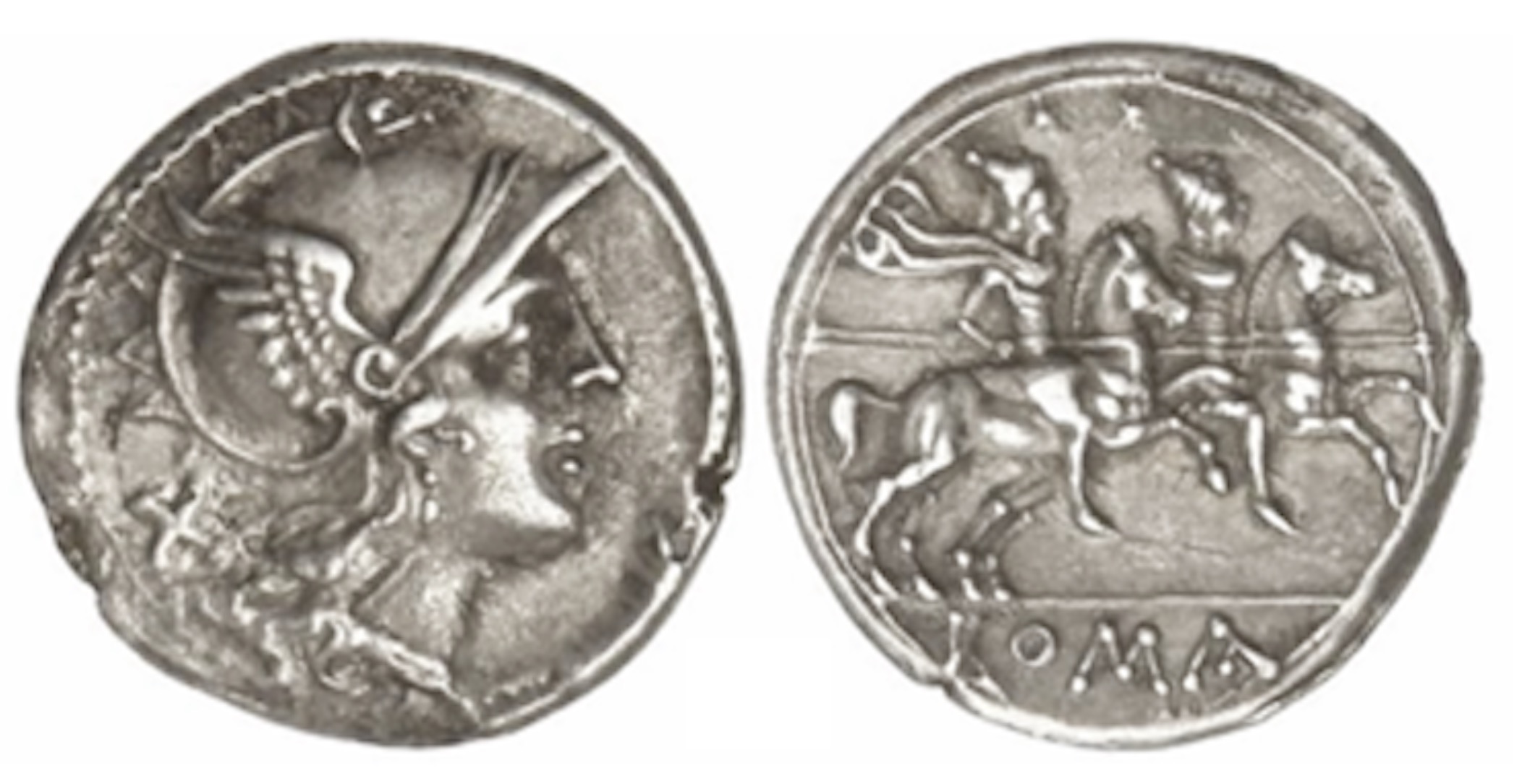 |
|
|
Review Numismatique group C4. This is a unique specimen of group C with streaming cape style and fully exergual line above ROMA.
This is the only known group C die with a streaming cape. Unknown beyond this single coin.
|
 |
|
Aureo & Calico Alba Longa Sale November 2018, lot 12 |
Sibling: RRC 88/2b (Spearhead), obverse style.
|
Group 6 - Curved Visor -
Broad Helmet(Review Numismatique - D2)
|
|
The helmet on these is usually rather broad with a visor curved downward on the
bottom edge, some variations of a similar style have a straight visor.
Always found with a "Streaming" cape.
|
19
RRC 53/2
X.17 |

Fig. 53/2.15 (RN-D2)
Photo Courtesy of Harlan Berk Ltd.

Fig. 53/2.16 (RN-D2)
Bibliothèque Nationale de France
|
|
This variety introduces the new style streaming cape, slightly different from that
found on group 3 dies. This style cape is carried forward for the
remainder of the 53/2 series.
Obverse: Tufts behind the head of Roma are close together (5). The
visor is curved slightly downward at the bottom edge. There are always two
relatively straight lines above the visor subtly splaying from their beginning
at the hinge to their ends near the periphery. The
obverse style of this and Group 5 is the similar.
Reverse: ROMA in 3 sided frame with bottom line unconnected.
The cape is “streaming” behind the rider.
Distinguishing Characteristics:
|
-
Broad head and helmet with slightly curved visor
-
Two lines above visor diverging slightly away from each other
-
Cape style Streaming
-
Griffon tufts on the back of the helmet are close together.
Weight Distribution Analysis:
A much smaller sample was available for group 6.
The Group 6 examples tend to be close to the 4.5 standard. |

|
Variation with similar style but smaller head and straight visor
=>
Note also the two raised lines above the helmet are not straight, but curved.
|

|
Sibling: RRC 88/2b (Spearhead with streaming cape variation)
|
Group 7 - Cornucopia Sibling - four
hair locks(Review Numismatique - D1)
|
|
This rare but distinct variety not pictured in the RRC plates, is characterized
by four locks of hair below the binding under the helmet, and a plain visor that
is slightly extended at the top edge. It is known by two reverse and three
obverse dies.
|
20
RRC 53/2
NIC |
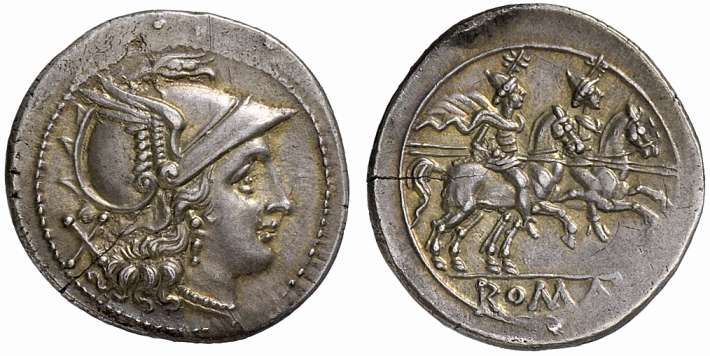
Fig. 53/2.17 (RN-D1)
Photo Courtesy of Numismatica Ars Classica,

Fig. 53/2.18 (RN-D1)
Muenzen und Medaillen Gmbh
Auction 19, Lot 517
|
|
Obverse: . Roma with four locks of hair on the neck, unlike
any other varieties except group 0. Large tufts on the back of the helmet.
The top edge of the plain peaked visor is slightly extended with one raised line
above.
Reverse: “Streaming” cape, Three sided frame around the legend ROMA along the Top, right, and bottom.
Distinguishing Characteristics:
|
-
Four locks of hair on Roma's neck
-
Upper edge of visor is slightly extended from the helmet
-
Relatively large tufts at the back of the helmet
-
Rectangular frame around ROMA legend
-
Streaming cape
Sibling: RRC 58/2 (Cornucopia)
|
Group 8 - Tall X
(Review Numismatique - D3)
|
|
The head of Roma is usually rather narrow with widely separated griffon tufts.
The "X" is narrow and tall. The top edge of the visor sometimes extends away from the helmet.
|
21
RRC 53/2
X.19 |

Fig. 53/2.19 (RN-D3)
Photo Courtesy Classical Numismatic Group

Fig. 53/2.20 (RN-D3)
Bibliothèque Nationale de France
|
|
Obverse: The most consistently distinguishing characteristic of this variety is the "X" mark of value which is tall and narrow,
unlike all other 53/2 varieties which are smaller and more symetrical. On some dies,
the top edge of the visor extends out from the helmet in a more blunt fashion.
Griffon tufts are large, well separated, and few.
Reverse: “Streaming” cape, Three sided frame along the Top, right, and bottom of the ROMA ledgend.
The ROMA ledgend is typically executed in tall fine lines.
Distinguishing Characteristics:
|
-
Large/Tall X mark of value
-
Well separated tufts at the back of the helmet
-
Streaming cape
-
Tiny "o" in RoMA, ledgend in fine, narrow lines.
Weight Distribution Analysis:
Again, a small sample for group 8 suggests an even distribution between the the two
standards. |

|
Very Rare hybrid with flag cape links this to group 4 or group 5. The three line cape suggests group 4.
The apparent exergual frame atop ROMA suggests group 5. The obverse style is mainline group 8.
=> |
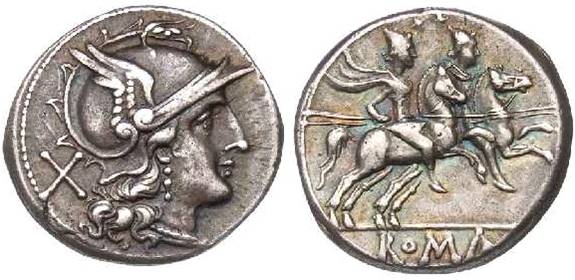
|
| Staatliche Museen zu
Berlin |
|
Group 9 - Star Sibling(Review Numismatique - E1-E2)
|
|
This is a large issue of the anonymous 53/2 group and most likely the latest. Although it is very common,
it is noticeably absent in important hoards dated to the 2nd Punic war period including the relatively large Orzivecchi and Piancastelli hoards
where these hoards contain other 53/2 varieties. This issue is characterized
by widely separated griffon tufts on the back of the helmet, usually only 4 or 5. Always a streaming
cape and and a rectangular 3 line frame around ROMA.
This large issue has several stylistic varieties and has siblings in the Star,
prow, and rudder series. The two most predominant varieties are the star/prow/rudder sibling
(RN-E1) and the large eyes / angular profile variety (RN-E2) shown in figures 53/2.21 and 53/2.22.
|
22
RRC 53/2
X.20 |

Fig. 53/2.21 (RN-E1)
Roma Numismatics, Auction 18, Lot 795
RN-E1 Variation, sibling to star symboled coins.

Fig. 53/2.22 (RN-E2)
Roma Numismatics, Auction 5, Lot 501
RN-E2 Variation with large eyes, angular profile.
|
|
Obverse: Two raised lines above visor. The tufts on the helmet are well separated (4-5). Sub-variety E1 tufts are widely separated and their points are directed upward like a fishhook barb.
Sub-variety E2 tufts are more triangular and pointing outward from the back of the helmet.
Reverse: The legend "ROMA" is raised within a lined border: two long lines above and below, and a short line on right.
Cape is “streaming” behind the rider. The tail of the far horse is never
present in background between
the horses' hind legs.
Distinguishing Characteristics:
|
-
Widely separated tufts behind the helmet
-
One raised lines above the visor
-
Reverse streaming cape
Weight Distribution Analysis:
Perhaps the most revealing of all, the Group 9 sample is large and clearly
suggests a 3.8 standard. This combined with its absence in many hoards
containing the earlier groups suggests that group 9 was is squarly in the
later period when the aim for a single coin was 3.8 gm.
A comparison of weight distribution with its star and prow siblings also
reinforces the relationship. |

|

|
Variations
This was a large issue, and almost certainly the latest.
The dies of this issue were obviously cut by many celators and many distinctive styles exist. Here are a few of the
most commonly encountered. The differentiation of the styles is largely recognized by the distinctions on the
obverse die
|
RN-E1 Large head and helmet
|

|
|
RN-E2 Large eye, angular face
|

|
Sibling: RRC 113/1 (star),
RRC 114/1
(Rostrum Tridens)
, C117a/1 (Rudder).
|


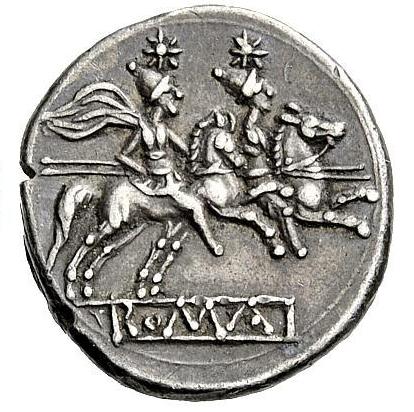
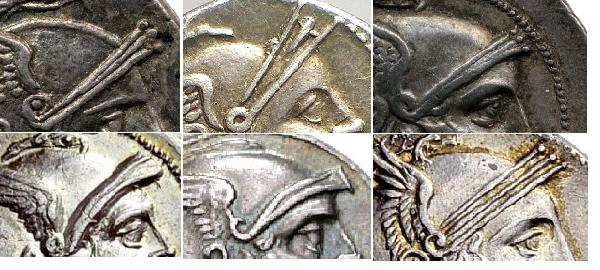







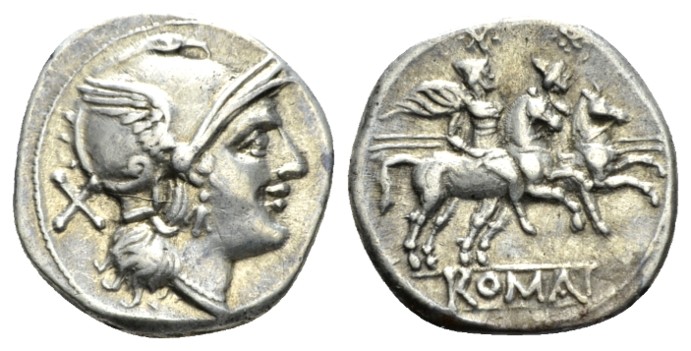


























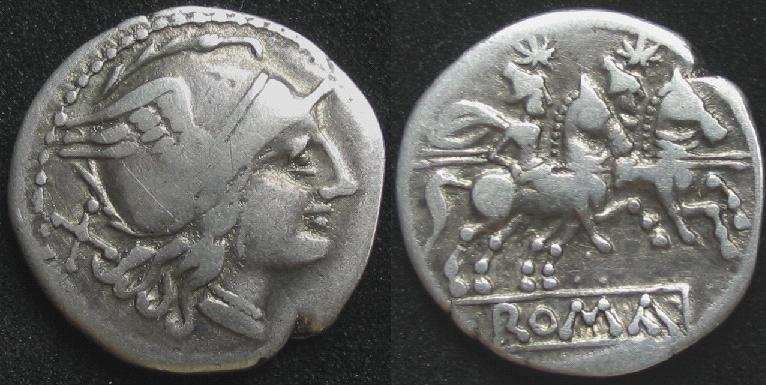






















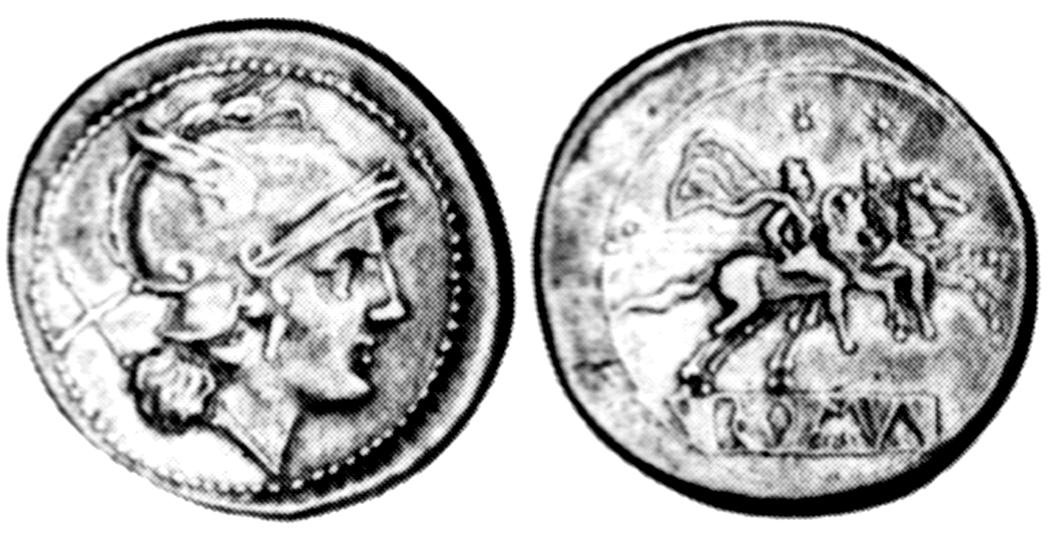



















.jpg)





.jpg)

























